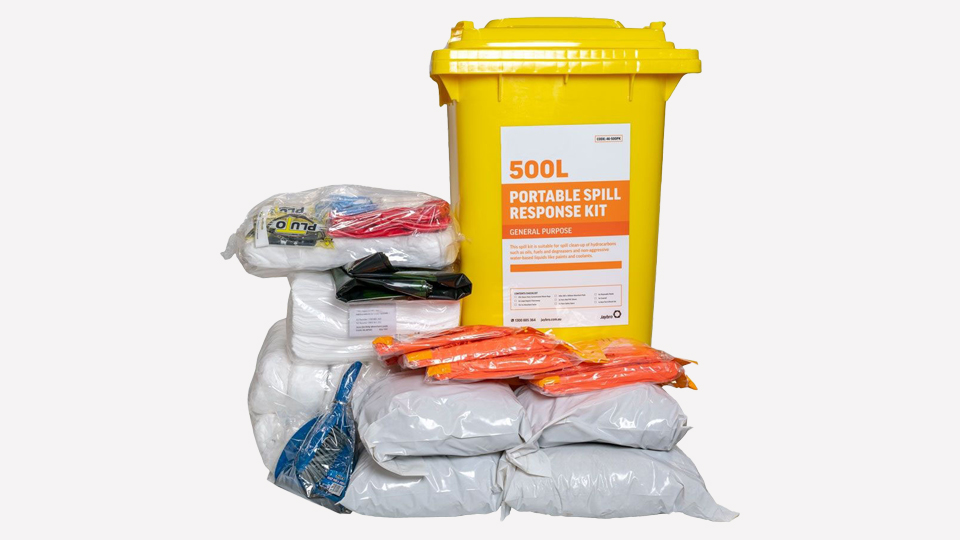How to Choose The Right Spill Kits

What are spill kits?
Spill kits are compact and convenient clean-up kits containing everything you need to quickly respond to spilled or leaking chemicals, oils, paints and other substances that present a slip hazard.
Spill kits come in different types and sizes depending on the volume of substances you store at your warehouse, site or depot. If you are storing large IBCs of chemicals, for example, it’s appropriate to have a larger-sized spill kit because of the potentially widespread spillage that could occur.
Large spill kits are generally packed in wheelie bins, and smaller kits come in soft satchels that are portable for fast and easy response to smaller spills.
Why are spill response kits necessary on site?
Accidents happen, even when you take the most stringent safety precautions. It’s wise to prepare for a potential spill with a kit that is suitable for the various substances you store on the job.
Because they come in small, handy containers and include all the materials you need to clean up a spill quickly, having one on site reduces the potential damage to your stock, property, the environment, and to employees. This is because spill response kits allow your team to clean up spills fast, mitigating the amount of damage done and reducing the time that the chemical, oil or substance is uncontained.
What is included in a spill kit?
- Booms and socks: these are soft, absorbent sausage-shaped pillows that are placed around the perimeter of the spill to help stop unwanted substances from spreading or entering stormwater drains. Booms and socks help to contain the spill to a smaller area, making it easier to clean up.
- Absorbent material such as sawdust: most spill kits contain an absorbent or neutralising material like sawdust, vermiculite or diatomaceous earth. Sodium bicarbonate is typically included in chemical or acid spill kits, as it acts to neutralise acidic substances.
- Garbage bags: thick, tough disposable bags are included so that workers can easily contain waste. All the used contents of the spill kit can go into the bags after use, and be disposed of appropriately.
- Protective equipment: most spill kits contain gloves, a disposable face mask and safety eyewear, and they may also contain disposable coveralls for extra safety around certain substances.
- Kits also consist of a container or bin to place the spilled chemicals in.
Types of spill kits and their uses
Spill kits come in different types and sizes with different contents, depending on whether you need to mop up hydrocarbons, oils, fuel, solvents, chemicals, acids or general spills. The size of a spill kit indicates how much liquid it will absorb, eg: a 40L spill kit contains the appropriate supplies to absorb 40 L of liquid.
General purpose spill kits
General purpose sorbent kits are suitable for mopping up most common liquids found on sites such as paints, coolant, blood, sewerage and contaminated water.
Oil or hydrocarbon spill kits
The special absorbent materials in these kits can soak up hydrocarbons and oils without filling them up with water. This means they can be used around wet areas and near lakes or other bodies of water. Oil and fuel kits will work on flammable liquid spills on hard surfaces as well as water. Kits such as the Sorbex 120L Marine Oil Spill Kit contain absorbent booms that float on the surface of the water and contain spills whilst also absorbing the spilt substances.
Chemical spill kits
Chemical spill kits are appropriate for sites where aggressive or corrosive chemicals are used, such as hydrofluoric acid, solvents, acids or pesticides. These kits will absorb both oil and water based liquids, however, the special type of sorbent material allows it to withstand highly aggressive chemicals.
What happens after a spill is cleaned up?
After a spill has been managed and all the liquid has been absorbed and disposed of, it’s important to restock your spill kit ready for next time. Almost all spill kits can be replenished with spill kit refill packs, so remember to re-order the necessary booms, socks, bags and PPE and add them to your spill bin ready for any future spills or leaks.
 Sign In
Sign In 

